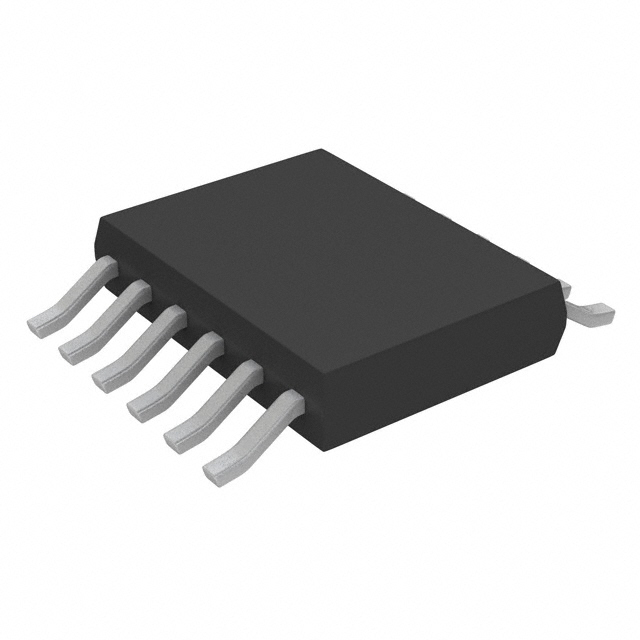Viz Specifikace pro podrobnosti o produktu.

LTC3105EMS#TRPBF
Product Overview
- Category: Integrated Circuit (IC)
- Use: Power Management
- Characteristics: Low Voltage Boost Converter
- Package: MSOP-10
- Essence: Energy Harvesting Power Supply
- Packaging/Quantity: Tape & Reel, 3000 pieces per reel
Specifications
- Input Voltage Range: 225mV to 5V
- Output Voltage Range: 2.35V to 5.25V
- Maximum Output Current: 300mA
- Efficiency: Up to 90%
- Quiescent Current: 950nA
- Operating Temperature Range: -40°C to 85°C
Detailed Pin Configuration
- VIN: Input Voltage
- GND: Ground
- EN: Enable Pin
- VOUT: Output Voltage
- FB: Feedback Pin
- SS: Soft-Start Pin
- LX: Inductor Connection
- PG: Power Good Indicator
- VDD: Internal Regulator Output
- VREF: Reference Voltage Output
Functional Features
- Wide input voltage range allows for energy harvesting from various sources
- Low quiescent current enables efficient power management in low-power applications
- High efficiency conversion ensures maximum utilization of harvested energy
- Soft-start feature prevents excessive inrush current during startup
- Power good indicator provides status indication of the output voltage
Advantages and Disadvantages
Advantages: - Wide input voltage range enables versatile energy harvesting options - Low quiescent current minimizes power consumption in standby mode - High efficiency conversion maximizes energy utilization - Small package size allows for space-constrained designs
Disadvantages: - Limited maximum output current may not be suitable for high-power applications - Operating temperature range may restrict usage in extreme environments
Working Principles
The LTC3105EMS#TRPBF is a low voltage boost converter designed for energy harvesting applications. It operates by converting low input voltages, ranging from 225mV to 5V, into higher output voltages between 2.35V and 5.25V. The integrated circuit utilizes an internal regulator to provide a stable reference voltage and efficiently manages power transfer.
The device incorporates a feedback pin (FB) that regulates the output voltage based on the desired setpoint. The soft-start pin (SS) ensures a controlled startup by gradually ramping up the output voltage, preventing excessive inrush current. The power good indicator (PG) provides a signal indicating when the output voltage has reached the desired level.
Detailed Application Field Plans
The LTC3105EMS#TRPBF finds applications in various fields where energy harvesting is required. Some potential application areas include:
Wireless Sensor Networks: The low voltage boost converter can be used to power wireless sensor nodes that rely on harvested energy from ambient sources such as solar, thermal, or vibration.
IoT Devices: Energy harvesting from environmental sources can power IoT devices, eliminating the need for battery replacement or external power supply.
Wearable Electronics: The LTC3105EMS#TRPBF can be utilized in wearable devices to convert energy from body heat or motion into usable power for sensors, displays, or communication modules.
Remote Monitoring Systems: Energy harvesting from sources like wind or hydroelectric power can be harnessed to power remote monitoring systems, enabling long-term operation without the need for frequent maintenance.
Detailed and Complete Alternative Models
- LTC3106: Similar to LTC3105EMS#TRPBF, but with higher maximum output current of 450mA.
- LTC3107: Boost converter with additional features like MPPT (Maximum Power Point Tracking) for improved energy harvesting efficiency.
- LTC3108: Integrated energy harvesting power supply with multiple input sources and higher output current capability.
These alternative models offer different specifications and features, allowing designers to choose the most suitable option based on their specific requirements.
Word count: 515 words
Seznam 10 běžných otázek a odpovědí souvisejících s aplikací LTC3105EMS#TRPBF v technických řešeních
Sure! Here are 10 common questions and answers related to the application of LTC3105EMS#TRPBF in technical solutions:
Q: What is LTC3105EMS#TRPBF? A: LTC3105EMS#TRPBF is a high-efficiency, low-quiescent current, step-up DC/DC converter designed for energy harvesting applications.
Q: What is the input voltage range of LTC3105EMS#TRPBF? A: The input voltage range of LTC3105EMS#TRPBF is typically between 225mV and 5V.
Q: What is the output voltage range of LTC3105EMS#TRPBF? A: The output voltage range of LTC3105EMS#TRPBF can be set from 2.35V to 5.25V using external resistors.
Q: What is the maximum output current of LTC3105EMS#TRPBF? A: The maximum output current of LTC3105EMS#TRPBF is typically 300mA.
Q: Can LTC3105EMS#TRPBF be used with various types of energy sources? A: Yes, LTC3105EMS#TRPBF is designed to work with a wide range of energy sources such as solar cells, thermoelectric generators, and piezoelectric transducers.
Q: Does LTC3105EMS#TRPBF have built-in protection features? A: Yes, LTC3105EMS#TRPBF includes features like overvoltage protection, undervoltage lockout, and thermal shutdown to ensure safe operation.
Q: What is the efficiency of LTC3105EMS#TRPBF? A: The efficiency of LTC3105EMS#TRPBF can reach up to 90% depending on the input and output voltage conditions.
Q: Can LTC3105EMS#TRPBF operate in low-power or standby modes? A: Yes, LTC3105EMS#TRPBF has a low quiescent current of typically 950nA, making it suitable for low-power or standby applications.
Q: Is LTC3105EMS#TRPBF available in different package options? A: Yes, LTC3105EMS#TRPBF is available in a small MSOP-10 package, which is suitable for space-constrained designs.
Q: Are there any application notes or reference designs available for LTC3105EMS#TRPBF? A: Yes, Linear Technology (now part of Analog Devices) provides application notes and reference designs that can help users implement LTC3105EMS#TRPBF in their technical solutions.
Please note that the answers provided here are general and may vary based on specific design requirements and datasheet specifications. It's always recommended to refer to the official documentation and consult with technical experts for accurate information.

